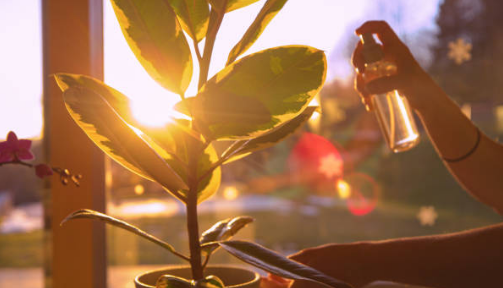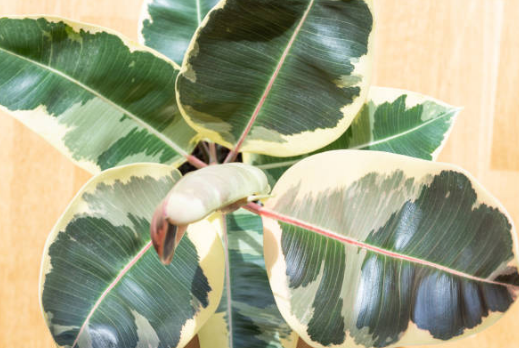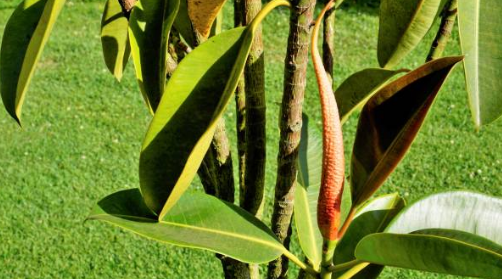
Ficus Tineke requires soil that drains well and is well-aerated. It thrives in bright indirect or direct sunlight. When the soil is completely dry, only deeply water the plant. 60-95°F (18-35°C) is the ideal range for growing plants. Continue reading, you will learn more care facts about ficus tineke.
Table of Contents
Ficus Tineke Care Guide
There are nine different elements for ficus tineke care.
Soil
The soil requirements for Ficus Tineke are comparable to those for Ficus Elastica. A well-draining, well-aerated soil is required for Ficus Tineke. Any soil type is acceptable as long as it drains properly. It is advised to use a potting mix that contains organic ingredients.
Most types of soil will support Ficus elastica Tineke growth, and they are not particularly fussy about it.
Good drainage is the only thing these plants require.
It’s not advised to use only regular garden or potting soil because it will likely become compacted and wet over time, causing poor drainage and aeration.
To create a potting mixture that your Ficus Tineke plant will adore, it is preferable to use a combination of substances.
You may still use garden soil in your potting mixture, but not more than 50%.
Along with regular soil, it’s advised to use other materials like peat, pine bark, or houseplant potting mix.
Using only houseplant potting mix to pot your plant is something that can be done, and your plant would love it. However, you might have to pay a fortune for it.
This recipe will help you create the ideal soil mixture for Ficus elastica Tineke.
- Normal soil (1 part)
- Peat (1 part)
- Perlite (1 part)
- Pine bark (1 part)
Perfect aeration and drainage are guaranteed when more than one or two potting media are used to prepare the soil mix.
Your Tineke Rubber plant will continue to be fed even if you don’t fertilize it because of organic components in the soil act as a slow-release fertilizer.
Watering
Like all Elastica species, Ficus Tineke doesn’t need much water. It is best to avoid overwatering these plants since they are susceptible to root rot.
Only when the soil is completely dry, preferably the first few inches, should you give it a generous drink of water.

A great way to water the plant is by soaking it.
In its natural habitat, Ficus Elastica grows in hot, humid jungles with little access to water. As a result, they don’t frequently water and will put up with being submerged.
Ficus elastica tineke can go several days without water because of its thick, glossy leaves, which help it retain a lot of moisture.
These plants typically need water once a week or twice a week during the spring and summer growing seasons.
To keep your plant from wilting in areas with higher temperatures and drier climates, you can water it on different days.
The watering schedule and frequency must be drastically changed for the winter months when you should only water these plants occasionally.
This is a result of the plant going into dormancy, which causes very low levels of transpiration.
Water your variegated Rubber plant sparingly in these circumstances since you don’t want extra moisture to sit in the soil for very long.
There is one watering routine you can stick to all year long, whether your water once every few weeks or twice a week.
That is consistently giving your plant a good drink.
Making sure the entire root ball is moistened when watering Ficus elastica will improve performance.
Water flowing out of the drainage hole is a sign that your plant has had a good drink.
One of the best watering techniques for rubber plants is the soak method. The entire pot should be placed inside a large tub that has been filled halfway with water.
The dry soil will consume the necessary amount of water. 4-5 minutes later, remove the pot from the tub.
By using the soak method, you can protect your plant from other watering-related issues while also making sure that the soil and roots of the plant receive enough water.
Temperature
Ficus Tineke enjoys a hot beverage. In locations with hot, humid weather, they will grow the fastest. The recommended growing range is 60-95°F (18-35°C).
The University of Florida advises residents of USDA zones 10b to 11 to grow Ficus Tineke as outdoor plants all year long.
The India-Indonesia native tropical plant thrives in warm conditions.
When purchasing the plant to grow at home, you must keep in mind that it is from areas where there is never a frost and it rarely gets below freezing.

A Ficus Elastica Tineke will only flourish in your possession if you have this knowledge.
This will help you understand whether or not you can grow a variegated Rubber fig outdoors or not in the sort of climate you live in.
This plant cannot survive in temperatures below 50°F (10°C). The tropical houseplant enters a dormant state during the winter.
Light
Bright light is ideal for the Ficus Tineke. Both direct sunlight and strong reflected light are suitable for it. But the foliage’s creamy variegation will become less pronounced in dim lighting.
Being a Ficus species, the Ficus Tineke can tolerate a wide range of light levels ranging from direct sunlight to a low-light corner in your room.
Give your Ficus Tineke a spot where it can receive continuous, obstructed sunlight if you are planting it outdoors.
Although this plant can grow into a large tree, it can also be grown close to a wall or in some light shade.
Therefore, think about this plant’s potential for future growth before deciding to give it a permanent spot in your garden.
If you are growing this plant in a pot, it will enjoy a spot on your patio and will also flourish indoors if it receives at least 6 hours per day of bright indirect light.
One of the most crucial factors to keep in mind when cultivating this plant in a pot is to avoid overexposing it to sunlight during the summer.
The sun will slow down growth and cause the leaves to burn and wilt.
In contrast, if not given enough light, Ficus Tineke will lose its lovely variegation and the cream portion of the leaves will become less prominent.
Put your Ficus Tineke close to a window that receives sufficient light each day in order to do it correctly.
Your plant will be able to grow healthily in the absence of sunlight with just six hours of bright indirect light per day.
Potting
The Variegated Rubber plant requires a pot with good drainage.
If you want your plant to become a bushy tree, use a large pot. For the purpose of soil aeration, clay pots are advised over other types.
The difference between a happy Ficus Tineke and a healthy, active one can be made entirely by the pot you choose.
The size of the root system it can support depends on the size of the pot you choose.
Growing roots will be restricted in a smaller pot, which will significantly slow down plant growth.

Pruning
Due to its slower growth rate as a houseplant, Ficus elastica won’t require pruning.
If you grow the plant into a medium-sized to large tree, pruning won’t be necessary. It’s simple to shape-prune, but be cautious of the sap that’s leaking out, as it could irritate your skin.
Ficus Tineke trees grow slowly, so you won’t need to prune them until they are a few years old.
Pruning the priceless foliage is wasteful because the plant’s growth is already slow in a pot.
Anytime during the year, you can prune it off to shape it if it gets too big.
Fertilizer
Ficus Tineke doesn’t entirely require fertilization. However, you can encourage robust and healthy foliage by giving it monthly doses of a mild liquid fertilizer.
The Rubber plant’s variegated variety is a light feeder. To maintain strong growth, however, every plant requires some nutrition.
It is a good idea to fertilize the soil once or twice a month when growing this plant in a container.
When the potting mix contains little organic matter, fertilization is even more important.
For plants grown outdoors or indoors, you can feed them with organic compost or a blend soluble in water.
Make sure to add the fertilizer far from the trunk and in moderation.
Growth
When planted in the ground, the rubber plant Tineke can develop into a giant tree that is 50 feet tall. Before the root system can no longer support the height, plants in pots typically grow to be 4-5 times the length of the pot. In humid environments, growth is most active.
Large, glossy, glossy leaves up to 12 inches long and 5 inches wide can be found on Ficus Tineke. This variety has a lovely three-color pattern.
This extraordinary variety’s foliage is something to drool over, with deep green in the center, light green just before the leaf border, and pale cream right at the edges.
Variegation results in a plant with less chlorophyll and slower growth than the Ficus elastica standard.
Humidity
High humidity is ideal for the growth of Ficus Tineke. For the plant to thrive, humidity levels must be kept at a minimum of 40 to 50 percent.
When growing indoors, humidity can be maintained with a humidifier or humidity tray.
This plant is indigenous to places with year-round humidity.
Replicating its native growing conditions as closely as possible is the best way to ensure that any plant thrives.
Avoid placing your Variegated Rubber plant in drafty areas, such as next to fans, air vents, or open windows during the winter.

Use a humidifier to increase the humidity. Another excellent and affordable option is to use a humidity tray.
Placing your Ficus Tineke pot inside a shallow tray is a good idea. Add pebbles to fill the empty space after half of the tray has been filled with water.
The pebbles and water will produce a superb level of humidity around the plant.
Ficus Tineke Propagation
Cuttings or air layering make it simple to spread Ficus Tineke during the spring or summer.
Both soil and water can be used to plant cuttings. By air layering, thicker stems can be propagated.
Make hardwood cuttings from the plant using tidy, well-kept pruners. To separate the cutting, cut at an angle.
Make sure they are placed in a warm, well-lit area and that the cuttings are submerged in clean drinking water.
The cuttings will root in six weeks. Alternately, place the cuttings in moist potting soil and provide a clear plastic bag over them to help retain moisture.
Common Problems With Ficus Tineke
Despite the relatively laid-back personalities of these plants, neglect or unsuitable conditions can still cause issues to arise. Observe the warning signs listed below.
Leaves Turning Yellow
The leaves of your ficus Tineke turning yellow is one of the first indications that you might be watering it too much. It might also be a sign that your plant is too drafty of a location.
Prior to rewatering, always check the soil. Wait a few days and recheck if the top few inches of soil still feel moist.
Plant Leaves Falling Off
Premature leaf drops can be caused by underwatering. In spite of the fact that some leaf loss is normal as a plant grows and concentrates its energy on newer growth, allowing a plant to become overly dry can cause the plant’s death. An indication that you might need to increase your watering schedule is premature leaf fall. In between waterings, keep the potting mix from drying out completely.
Brown Tips
Possibly sitting in the excessively direct sun are leaves that become crispy and develop brown tips. To avoid this, move your plant to a location with more dappled light.
How Often Should You Water Ficus Tineke?
A rubber tree needs watering, but how frequently? The best time to water your Rubber Tree is once every two to four weeks, allowing the soil to dry out in between. When the plant is exposed to more light, such as in the spring or summer, choose the higher end of the frequency range; in the fall or winter, choose the lower end of the range.

FAQ About Ficus Tineke Care
How to Increase Variegation in Ficus Tineke?
Intense light and cool temperatures are the two main factors that cause variegation in plants. Although the two are difficult to manage at the same time, you can artificially create this environment by putting your Ficus Tineke in a room with bright lighting and air conditioning.
How Long Can My Ficus Tineke Live?
If you give your plant good care, it should live for at least a few decades. These resilient plants have been known to live for 100 years in the right outdoor conditions.
Why is the Variegation Fading on My Ficus Tineke?
Lack of light is the main cause of the pink hues on these plants disappearing. A location with access to bright, filtered light is crucial to maintaining the striking variegation even though they don’t thrive in spots with continuous exposure to intense, direct sunlight.
How Fast Does the Ficus Tineke Grow?
With an average annual growth rate of up to 24 inches, variegated rubber plants are comparatively quick-growing. They can grow up to 10 feet tall when grown indoors, but under the right outdoor conditions, they can grow even faster and much higher.
Does Ficus Tineke Have Aerial Roots?
When the humidity level is high, the Ficus Tineke usually produces aerial roots. The Tineke variety is, however, somewhat less likely to generate a lot of aerial root growth. When kept in a very humid environment with rocks positioned around the trunk, this plant might develop a few aerial roots.
Conclusion About Ficus Tineke Care
Ficus Tineke is a unique plant that is surely a treat to grow.
This plant is extremely simple to maintain, and the unique variegated foliage that results from good maintenance is even greater.
You can grow it outside or inside. This plant will grow on its own and rarely require special care.